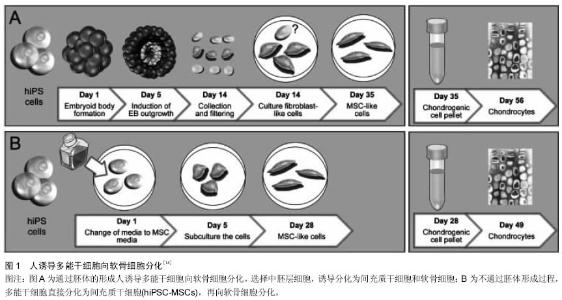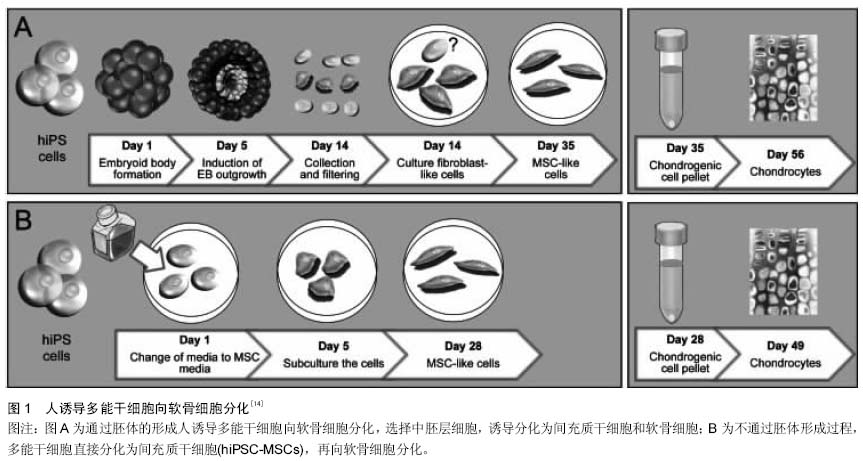Chinese Journal of Tissue Engineering Research ›› 2015, Vol. 19 ›› Issue (29): 4736-4741.doi: 10.3969/j.issn.2095-4344.2015.29.028
Previous Articles Next Articles
Tissue engineering technology for articular cartilage repair: how to construct a new compound pattern?
Yang Rui-tao1, Song Hui-ping2
- 1North China University of Science and Technology, Tangshan 063000, Hebei Province, China;
2Department of Orthopedics, Affiliated Hospital of North China University of Science and Technology, Tangshan 063000, Hebei Province, China
-
Contact:Song Hui-ping, M.D., Professor, Master’s supervisor, Chief physician, Department of Orthopedics, Affiliated Hospital of North China University of Science and Technology, Tangshan 063000, Hebei Province, China -
About author:Yang Rui-tao, Master, Physician, North China University of Science and Technology, Tangshan 063000, Hebei Province, China -
Supported by:the Natural Science Foundation of Hebei Province, No. C2011401025
CLC Number:
Cite this article
Yang Rui-tao, Song Hui-ping. Tissue engineering technology for articular cartilage repair: how to construct a new compound pattern? [J]. Chinese Journal of Tissue Engineering Research, 2015, 19(29): 4736-4741.
share this article
| [1] Emans PJ, Surtel DA, Frings EJ, et al.In vivo generation of cartilage from periosteum. Tissue Eng.2005;11(3-4):369-377. [2] Steadman JR, Briggs KK, Rodrigo JJ, et al.Outcomes of microfracture for traumatic chondral defects of the knee: average 11-year follow-up. Arthroscopy. 2003;19(5):477-484.
[3] Mobasheri A, Kalamegam G, Musumeci G, et al. Chondrocyte and mesenchymal stem cell-based therapies for cartilage repair in osteoarthritis and related orthopaedic conditions. Maturitas.2014;78(3):188-198.
[4] Goldberg AJ, Lee DA, Bader DL,et al.Autologous chondrocyte implantation. Culture in a TGF-beta-containing medium enhances the re-expression of a chondrocytic phenotype in passaged human chondrocytes in pellet culture. J Bone Joint Surg Br. 2005;87(1):128-134.
[5] BaqhabanEslaminejad M, Malakooty Poor E. Mesenchymal stem cells as a potent cell source for articular cartilage regeneration. World J Stem Cells.2014;6(3):344-354.
[6] Bornes TD, Adesida AB, Jomha NM. Mesenchymal stem cells in the treatment of traumatic articular cartilage defects: a comprehensive review. Arthritis Res Ther. 2014;16(5): 432.
[7] Fridenshte?n AIa. Stromal bone marrow cells and the hematopoietic microenvironment.Arkh Patol.1982;44:3-11.
[8] Song Z, Wu C, Sun S, et al. Quantitative analysis of factors influencing tissue-engineered bone formation by detecting the expression levels of alkaline phosphatase and bone γ-carboxyglutamate protein 2. ExpTher Med.2015;9(4): 1097-1102.
[9] Zhu L, Jiang H, Zhou GD, et al. Preliminary study of constructing tissue-engineered cartilage with the endoskeletal scaffold of HDPE by bone marrow stromal cells. Zhonghua Zheng Xing WaiKeZaZhi. 2008;24(5):377-381.
[10] Stromps JP, Paul NE,Rath B,et al. Chondrogenic differentiation of human adipose-derived stem cells: a new path in articular cartilage defect management? Biomed Res Int.2014;2014:740926.
[11] Peppo GM, Svensson S, LennerasM, et al. Human embryonic mesodermal progenitors highly resemble human mesenchymal stem cells and display high potential for tissue engineering applications. Tissue Eng Part A.2010; 16(7):2161-2182.
[12] Toh WS, Lee EH, Guo XM, et al. Cartilage repair using hyaluronan hydrogel-encapsulated human embryonic stem cell-derived chondrogenic cells. Biomaterials.2010;31(27): 6968-6980.
[13] Wu L, Bluguermann C, Kyupelyan L, et al. Human developmental chondrogenesis as a basis for engineering chondrocytes from pluripotent stem cells. Stem Cell Reports. 2013;1(6):575-89.
[14] Nejadnik H, Diecke S, Lenkov OD, et al. Improved Approach for Chondrogenic Differentiation of Human Induced Pluripotent Stem Cells. Stem Cell Rev. 2015Jan 13. [Epub ahead of print]
[15] Medvedev SP, Grigor'eva EV, Shevchenko AI, et al. Human induced pluripotent stem cells derived from fetal neural stem cells successfully undergo directed differentiation into cartilage. Stem Cells Dev.2011;20(6):1099-112.
[16] Nestor MW, Paull D, Jacob S, et al. Differentiation of serum-free embryoid bodies from human induced pluripotent stem cells into networks. Stem Cell Res. 2013; 10(3):454-63.
[17] Taghiabadi E, Nasri S, Shafieyan S, et al. Fabrication and characterization of spongy denuded amniotic membrane based scaffold for tissue engineering.Cell J. 2015;16(4): 476-87.
[18] Sridhar BV, Brock JL, Silver JS,et al. Development of a Cellularly Degradable PEG Hydrogel to Promote Articular Cartilage Extracellular Matrix Deposition.AdvHealthc Mater.2015 Jan 21.
[19] Nanda HS, Chen S, Zhang Q, et al. Collagen scaffolds with controlled insulin release and controlled pore structure for cartilage tissue engineering. Biomed Res Int. 2014;2014: 623805.
[20] Yan S, Wang T, Feng L, et al. Injectable in situ self-crosslinking hydrogels based on poly(L-glutamic acid)and alginate for cartilage tissue engineering. Biomacromolecules. 2014;15(12):4495-508.
[21] Stocco E, Barbon S, Dalzoppo D, et al. Tailored PVA/ECM Scaffolds for Cartilage Regeneration. Biomed Res Int.2014: 762189.
[22] Wang YC, Meng HY, Yuan XL, et al. Fabrication and in vitro evaluation of an articular cartilage extracellular matrix-hydroxyapatite bilayered scaffold with low permeability for interface tissue engineering. BioMedical Engineering Online.2014;13:80.
[23] Liu J, Nie H, Xu Z, et al.The effect of 3D nano fibrous scaffolds on the chondrogenesis of induced pluripotent stem cells and their application in restoration of cartilage defects. PLoS One.2014;9(11):e111566.
[24] Chaudhury K, Kumar V, Kandasamy J, et al.Regenerative nanomedicine: current perspectives and future directions. Int J Nanomedicine,2014;9:4153-4167.
[25] Lim EH, Sardinha JP, Myers S. Nanotechnology Biomimetic Cartilage Regenerative Scaffolds. Arch Plast Surg.2014; 41(3):231-240.
[26] Gu M, Liu Y, Chen T, Du F, et al.Is graphene a promising nano-material for promoting surface modification of implants or scaffold materials in bone tissue engineering? Tissue Eng Part B Rev.2014;20(5):477-491.
[27] Lee WC, Lim CH, Kenry, et al. Cell-assembled graphene biocomposite for enhanced chondrogenic differentiation. Small.2015;11(8):963-969.
[28] Klangjorhor J, Phitak T, Pruksakorn D, et al. Comparison of growth factor adsorbed scaffold and conventional scaffold with growth factor supplemented media for primary human articular chondrocyte 3D culture. BMC Biotechnol. 2014; 14(1):959.
[29] Murphy MK, Huey DJ, Hu JC, et al. TGF-β1, GDF-5, and BMP-2 Stimulation Induces Chondrogenesis in Expanded Human Articular Chondrocytes and Marrow-Derived Stromal Cells. Stem Cells.2015;33(3):762-773.
[30] Frisch J,Venkatesan JK, Rey-Rico A, et al. Determination of the chondrogenic differentiation processes in human bone marrow-derived mesenchymal stem cells genetically modified to overexpress transforming growth factor-β via recombinant adeno-associated viral vectors. Hum Gene Ther. 2014;25(12): 1050-1060.
[31] Rocha PM, Santo VE, Gomes ME, et al.Encapsulation of adipose-derived stem cells and transforming growth factor-1in carrageenan-based hydrogels for cartilage tissue engineering. J BioactCompatPolym, 2011;26 (5): 493-507.
[32] Karl A, Olbrich N, Pfeifer C, et al. Thyroid hormone-induced hypertrophy in mesenchymal stem cell chondrogenesis is mediated by bone morphogenetic protein-4. Tissue Eng Part A.2014;20(1-2):178-188.
[33] Jiang Y, Chen LK, Zhu DC, et al. The inductive effect ofbone morphogenetic protein-4 on chondral-lineage differentiation and in situ cartilage repair. Tissue Eng Part A.2010;16(5): 1621-32.
[34] Elder S, Thomason J. Effect of Platelet-Rich Plasma on Chondrogenic Differentiation in three-dimensional culture. Open Orthop J. 2014 ;8:78-84.
[35] Mascarenhas R, Saltzman BM, Fortier LA, et al. Role of platelet-rich plasma in articular cartilage injury and disease. J Knee Surg.2015;28(1):3-10.
[36] Wang Y, Kim UJ, Blasioli DJ, et al. In vitro cartilage tissue engineering with 3D porous aqueous-derived silk scaffolds and mesenchymal stem cells.Biomaterials. 2005;26: 7082-7094.
[37] Man Z, Yin L, Shao Z, et al. The effects of co-delivery of BMSC-affinity peptide and rhTGF-β1 from coaxial electrospun scaffolds on chondrogenic differentiation. Biomaterials. 2014; 35(19):5250-5360.
[38] Zhu L, Wu Y, Jiang H, et al.Engineered cartilage with internal porous high-density polyethylene support from bone marrow stromal cells: A preliminary study in nude mice.Br J Oral Maxillofac Surg.2010;48(6):462-465.
[39] Araki S, Imai S, Ishigaki H, et al.Improved quality of cartilage repair by bone marrow mesenchymal stem cells for treatment of an osteochondral defect in a cynomolgus macaque model. ActaOrthop.2015;86(1):119-126. |
| [1] | Pu Rui, Chen Ziyang, Yuan Lingyan. Characteristics and effects of exosomes from different cell sources in cardioprotection [J]. Chinese Journal of Tissue Engineering Research, 2021, 25(在线): 1-. |
| [2] | Lin Qingfan, Xie Yixin, Chen Wanqing, Ye Zhenzhong, Chen Youfang. Human placenta-derived mesenchymal stem cell conditioned medium can upregulate BeWo cell viability and zonula occludens expression under hypoxia [J]. Chinese Journal of Tissue Engineering Research, 2021, 25(在线): 4970-4975. |
| [3] | Zhang Xiumei, Zhai Yunkai, Zhao Jie, Zhao Meng. Research hotspots of organoid models in recent 10 years: a search in domestic and foreign databases [J]. Chinese Journal of Tissue Engineering Research, 2021, 25(8): 1249-1255. |
| [4] | Hou Jingying, Yu Menglei, Guo Tianzhu, Long Huibao, Wu Hao. Hypoxia preconditioning promotes bone marrow mesenchymal stem cells survival and vascularization through the activation of HIF-1α/MALAT1/VEGFA pathway [J]. Chinese Journal of Tissue Engineering Research, 2021, 25(7): 985-990. |
| [5] | Shi Yangyang, Qin Yingfei, Wu Fuling, He Xiao, Zhang Xuejing. Pretreatment of placental mesenchymal stem cells to prevent bronchiolitis in mice [J]. Chinese Journal of Tissue Engineering Research, 2021, 25(7): 991-995. |
| [6] | Liang Xueqi, Guo Lijiao, Chen Hejie, Wu Jie, Sun Yaqi, Xing Zhikun, Zou Hailiang, Chen Xueling, Wu Xiangwei. Alveolar echinococcosis protoscolices inhibits the differentiation of bone marrow mesenchymal stem cells into fibroblasts [J]. Chinese Journal of Tissue Engineering Research, 2021, 25(7): 996-1001. |
| [7] | Fan Quanbao, Luo Huina, Wang Bingyun, Chen Shengfeng, Cui Lianxu, Jiang Wenkang, Zhao Mingming, Wang Jingjing, Luo Dongzhang, Chen Zhisheng, Bai Yinshan, Liu Canying, Zhang Hui. Biological characteristics of canine adipose-derived mesenchymal stem cells cultured in hypoxia [J]. Chinese Journal of Tissue Engineering Research, 2021, 25(7): 1002-1007. |
| [8] | Geng Yao, Yin Zhiliang, Li Xingping, Xiao Dongqin, Hou Weiguang. Role of hsa-miRNA-223-3p in regulating osteogenic differentiation of human bone marrow mesenchymal stem cells [J]. Chinese Journal of Tissue Engineering Research, 2021, 25(7): 1008-1013. |
| [9] | Lun Zhigang, Jin Jing, Wang Tianyan, Li Aimin. Effect of peroxiredoxin 6 on proliferation and differentiation of bone marrow mesenchymal stem cells into neural lineage in vitro [J]. Chinese Journal of Tissue Engineering Research, 2021, 25(7): 1014-1018. |
| [10] | Zhu Xuefen, Huang Cheng, Ding Jian, Dai Yongping, Liu Yuanbing, Le Lixiang, Wang Liangliang, Yang Jiandong. Mechanism of bone marrow mesenchymal stem cells differentiation into functional neurons induced by glial cell line derived neurotrophic factor [J]. Chinese Journal of Tissue Engineering Research, 2021, 25(7): 1019-1025. |
| [11] | Duan Liyun, Cao Xiaocang. Human placenta mesenchymal stem cells-derived extracellular vesicles regulate collagen deposition in intestinal mucosa of mice with colitis [J]. Chinese Journal of Tissue Engineering Research, 2021, 25(7): 1026-1031. |
| [12] | Pei Lili, Sun Guicai, Wang Di. Salvianolic acid B inhibits oxidative damage of bone marrow mesenchymal stem cells and promotes differentiation into cardiomyocytes [J]. Chinese Journal of Tissue Engineering Research, 2021, 25(7): 1032-1036. |
| [13] | Guan Qian, Luan Zuo, Ye Dou, Yang Yinxiang, Wang Zhaoyan, Wang Qian, Yao Ruiqin. Morphological changes in human oligodendrocyte progenitor cells during passage [J]. Chinese Journal of Tissue Engineering Research, 2021, 25(7): 1045-1049. |
| [14] | Wang Zhengdong, Huang Na, Chen Jingxian, Zheng Zuobing, Hu Xinyu, Li Mei, Su Xiao, Su Xuesen, Yan Nan. Inhibitory effects of sodium butyrate on microglial activation and expression of inflammatory factors induced by fluorosis [J]. Chinese Journal of Tissue Engineering Research, 2021, 25(7): 1075-1080. |
| [15] | Wang Xianyao, Guan Yalin, Liu Zhongshan. Strategies for improving the therapeutic efficacy of mesenchymal stem cells in the treatment of nonhealing wounds [J]. Chinese Journal of Tissue Engineering Research, 2021, 25(7): 1081-1087. |
| Viewed | ||||||
|
Full text |
|
|||||
|
Abstract |
|
|||||

